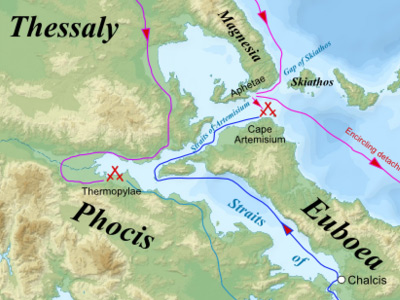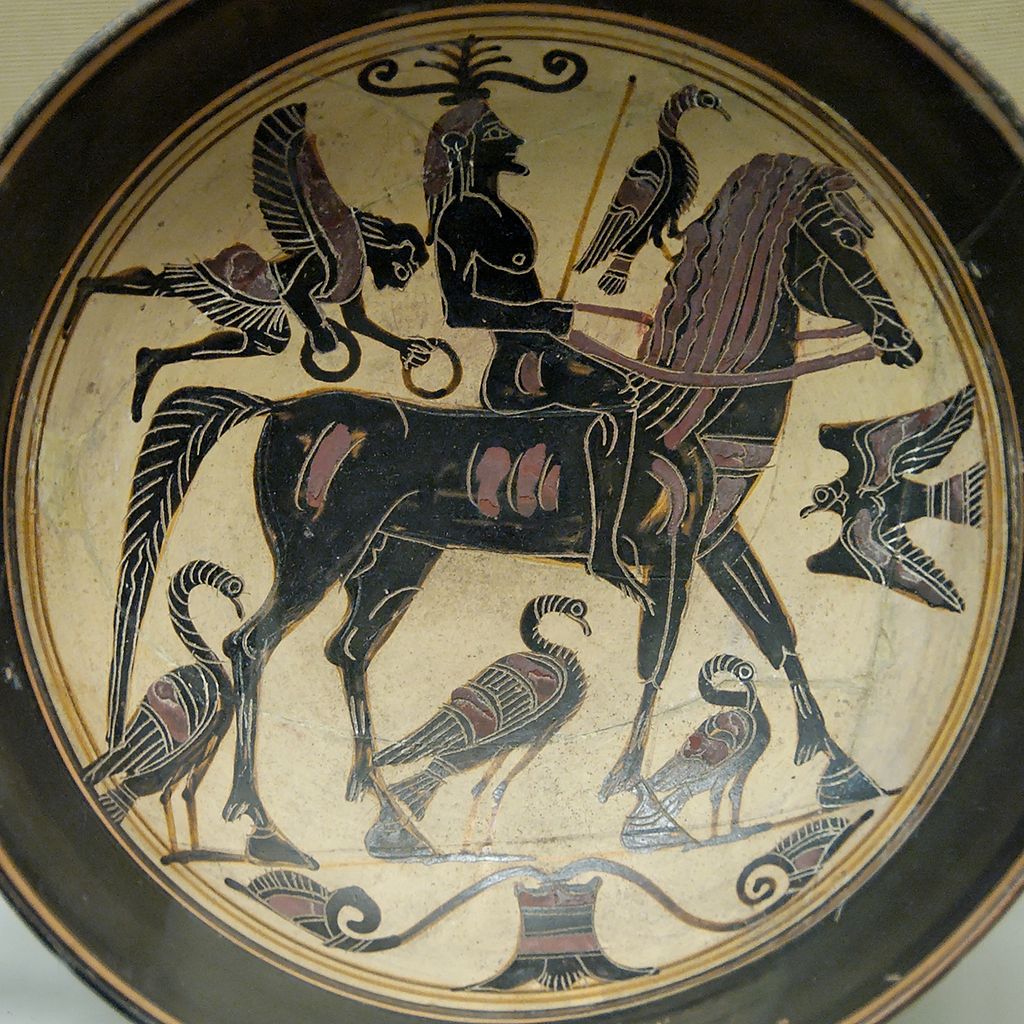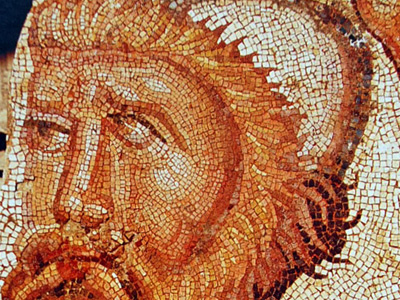Battle of Thermopylae (480 BC)
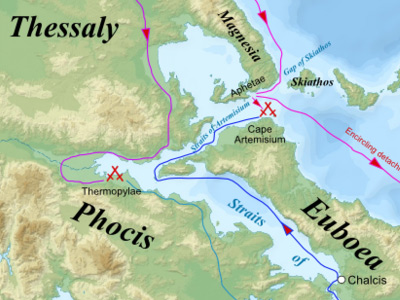
Aftermath
When the Persians recovered Leonidas' body, Xerxes, in a rage against Leonidas, ordered that the head be cut off and the body crucified. Herodotus observes this was very uncommon for the Persians, as they traditionally treated "valiant warriors" with great honour (the example of Pytheas, captured off Skiathos before the Battle of Artemisium, strengthens this suggestion). However, Xerxes was known for his rage. Legend has it that he had the very water of the Hellespont whipped because it would not obey him.
After the Persians' departure, the Greeks collected their dead and buried them on the hill. After the Persian invasion was repulsed, a stone lion was erected at Thermopylae to commemorate Leonidas. A full 40 years after the battle, Leonidas' bones were returned to Sparta, where he was buried again with full honors; funeral games were held every year in his memory.
With Thermopylae now opened to the Persian army, the continuation of the blockade at Artemisium by the Greek fleet became irrelevant. The simultaneous naval Battle of Artemisium had been a tactical stalemate, and the Greek navy was able to retreat in good order to the Saronic Gulf, where they helped to ferry the remaining Athenian citizens to the island of Salamis.
Following Thermopylae, the Persian army proceeded to sack and burn Plataea and Thespiae, the Boeotian cities that had not submitted, before it marched on the now evacuated city of Athens. Meanwhile, the Greeks (for the most part Peloponnesians) preparing to defend the Isthmus of Corinth, demolished the single road that led through it and built a wall across it. As at Thermopylae, making this an effective strategy required the Greek navy to stage a simultaneous blockade, barring the passage of the Persian navy across the Saronic Gulf, so that troops could not be landed directly on the Peloponnese. However, instead of a mere blockade, Themistocles persuaded the Greeks to seek a decisive victory against the Persian fleet. Luring the Persian navy into the Straits of Salamis, the Greek fleet was able to destroy much of the Persian fleet in the Battle of Salamis, which essentially ended the threat to the Peloponnese.
Fearing the Greeks might attack the bridges across the Hellespont and trap his army in Europe, Xerxes now retreated with much of the Persian army back to Asia, though nearly all of them died of starvation and disease on the return voyage. He left a handpicked force, under Mardonius, to complete the conquest the following year. However, under pressure from the Athenians, the Peloponnesians eventually agreed to try to force Mardonius to battle, and they marched on Attica. Mardonius retreated to Boeotia to lure the Greeks into open terrain, and the two sides eventually met near the city of Plataea. At the Battle of Plataea, the Greek army won a decisive victory, destroying much of the Persian army and ending the invasion of Greece. Meanwhile, at the near-simultaneous naval Battle of Mycale, they also destroyed much of the remaining Persian fleet, thereby reducing the threat of further invasions.
Thermopylae is arguably the most famous battle in European ancient history, repeatedly referenced in ancient, recent, and contemporary culture. In Western culture at least, it is the Greeks who are lauded for their performance in battle. However, within the context of the Persian invasion, Thermopylae was undoubtedly a defeat for the Greeks. It seems clear that the Greek strategy was to hold off the Persians at Thermopylae and Artemisium; whatever they may have intended, it was presumably not their desire to surrender all of Boeotia and Attica to the Persians. The Greek position at Thermopylae, despite being massively outnumbered, was nearly impregnable. If the position had been held for even a little longer, the Persians might have had to retreat for lack of food and water. Thus, despite the heavy losses, forcing the pass was strategically a Persian victory, but the successful retreat of the bulk of the Greek troops was in its own sense a victory as well. The battle itself had showed what a few free men, willing to do anything for victory against the invaders, could accomplish, and the defeat at Thermopylae had turned Leonidas and the men under his command into martyrs. That boosted the morale of all Greek soldiers in the second Persian invasion.
It is sometimes stated that Thermopylae was a Pyrrhic victory for the Persians (i.e., one in which the victor is as damaged by the battle as the defeated party). However, there is no suggestion by Herodotus that the effect on the Persian forces was that. The idea ignores the fact that the Persians would, in the aftermath of Thermopylae, conquer the majority of Greece, and the fact that they were still fighting in Greece a year later. Alternatively, the argument is sometimes advanced that the last stand at Thermopylae was a successful delaying action that gave the Greek navy time to prepare for the Battle of Salamis. However, compared to the probable time (about one month) between Thermopylae and Salamis, the time bought was negligible. Furthermore, this idea also neglects the fact that a Greek navy was fighting at Artemisium during the Battle of Thermopylae, incurring losses in the process. George Cawkwell suggests that the gap between Thermopylae and Salamis was caused by Xerxes' systematically reducing Greek opposition in Phocis and Boeotia, and not as a result of the Battle of Thermopylae; thus, as a delaying action, Thermopylae was insignificant compared to Xerxes' own procrastination. Far from labeling Thermopylae as a Pyrrhic victory, modern academic treatises on the Greco-Persian Wars tend to emphasise the success of Xerxes in breaching the formidable Greek position and the subsequent conquest of the majority of Greece. For instance, Cawkwell states: "he was successful on both land and sea, and the Great Invasion began with a brilliant success ... Xerxes had every reason to congratulate himself", while Lazenby describes the Greek defeat as "disastrous".
The fame of Thermopylae is thus principally derived not from its effect on the outcome of the war but for the inspirational example it set. Thermopylae is famous because of the heroism of the doomed rearguard, who, despite facing certain death, remained at the pass. Ever since, the events of Thermopylae have been the source of effusive praise from many sources: "...the fairest sister-victories which the Sun has ever seen, yet they would never dare to compare their combined glory with the glorious defeat of King Leonidas and his men." A second reason is the example it set of free men, fighting for their country and their freedom:
So almost immediately, contemporary Greeks saw Thermopylae as a critical moral and culture lesson. In universal terms, a small, free people had willingly outfought huge numbers of imperial subjects who advanced under the lash. More specifically, the Western idea that soldiers themselves decide where, how, and against whom they will fight was contrasted against the Eastern notion of despotism and monarchy—freedom proving the stronger idea as the more courageous fighting of the Greeks at Thermopylae, and their later victories at Salamis and Plataea attested.
While this paradigm of "free men" outfighting "slaves" can be seen as a rather sweeping over-generalization (there are many counter-examples), it is nevertheless true that many commentators have used Thermopylae to illustrate this point.
Militarily, although the battle was actually not decisive in the context of the Persian invasion, Thermopylae is of some significance on the basis of the first two days of fighting. The performance of the defenders is used as an example of the advantages of training, equipment, and good use of terrain as force multipliers.
HISTORY
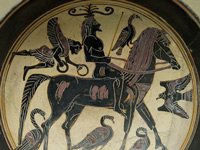
RESOURCES
This article uses material from the Wikipedia article "Battle of Thermopylae", which is released under the Creative Commons Attribution-Share-Alike License 3.0.
© Stories Preschool. All Rights Reserved.
